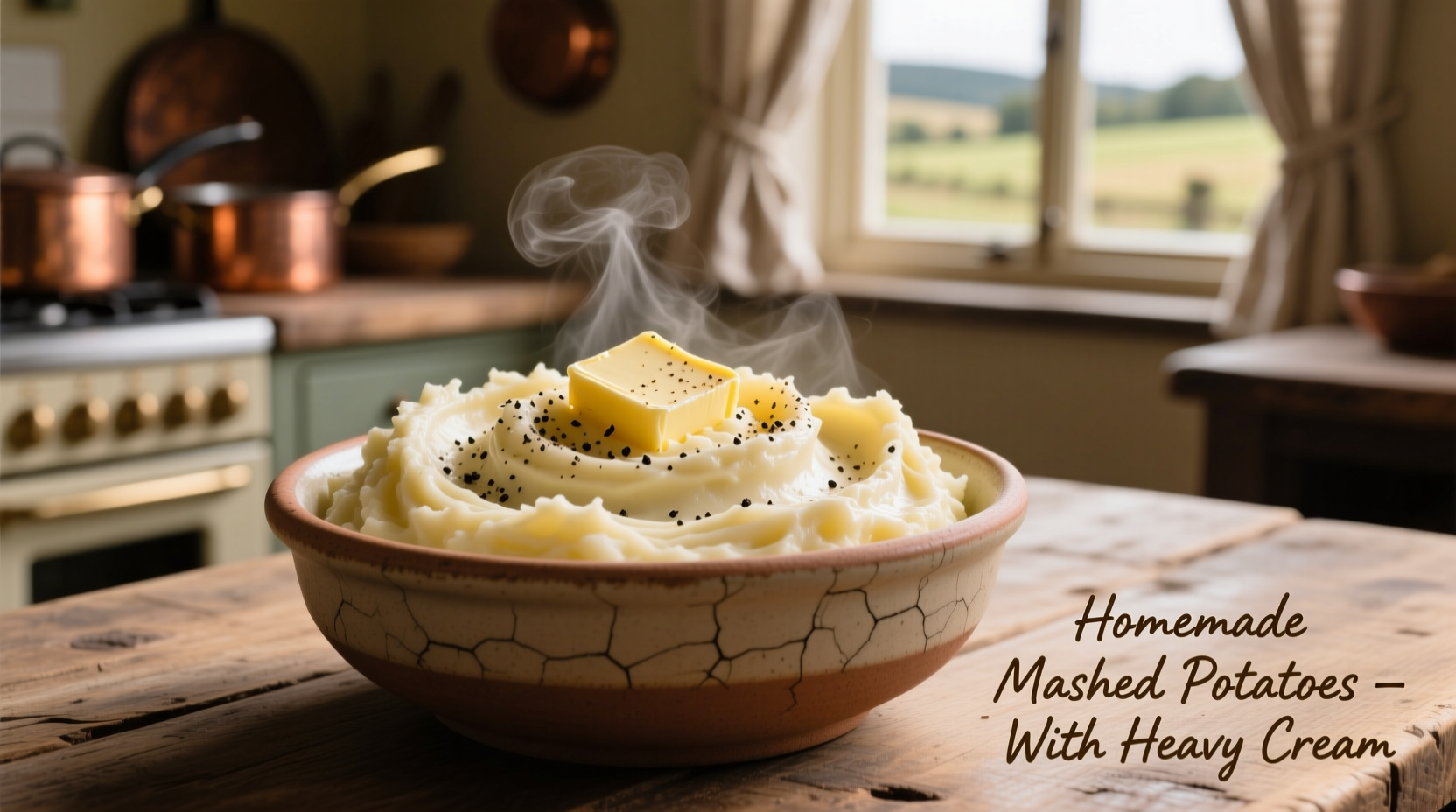Get restaurant-quality creamy mashed potatoes with this simple recipe using heavy cream. You'll achieve perfectly smooth, rich texture without gluey consistency by following our precise ratio of 1 cup heavy cream to 2 pounds potatoes, heated to 160°F before incorporation. This method prevents curdling while maximizing creaminess for holiday dinners or weeknight meals.
The Science Behind Creamy Mashed Potatoes
Heavy cream transforms ordinary mashed potatoes into an indulgent side dish through its high fat content (36-40%). Unlike milk or half-and-half, heavy cream's fat molecules coat starch granules more effectively, preventing water absorption that causes gummy texture. Food science research from the USDA National Institute of Food and Agriculture confirms that dairy products with higher fat content create more stable emulsions in starch-based dishes.
| Dairy Option | Fat Content | Texture Result | Best For |
|---|---|---|---|
| Heavy Cream | 36-40% | Ultra-smooth, rich | Holiday meals, special occasions |
| Half-and-Half | 10.5-18% | Creamy but less luxurious | Everyday meals |
| Whole Milk | 3.25% | Lighter, more traditional | When watching fat intake |
| Sour Cream | 18-20% | Tangy, dense | Flavor variations |
Perfect Mashed Potato Ratio Guide
Professional kitchens follow precise measurements for consistent results. For the creamiest texture without excess richness:
- 2 pounds Yukon Gold potatoes (peeled and cubed)
- 1 cup heavy cream (warmed to 160°F)
- 4 tablespoons unsalted butter (room temperature)
- 1½ teaspoons kosher salt (plus more to taste)
- ¼ teaspoon white pepper
Step-by-Step Preparation
1. Potato Selection and Preparation
Yukon Gold potatoes contain the ideal starch-to-moisture ratio for creamy mashed potatoes. Russets work too but require careful handling to avoid graininess. Cut potatoes into uniform 1½-inch cubes for even cooking. Soak in cold water for 15 minutes to remove excess surface starch.
2. Cooking Process
Place potatoes in a large pot, cover with cold water by 1 inch, and add 1 tablespoon salt. Bring to a gentle boil (not rapid) to prevent uneven cooking. Simmer 15-18 minutes until fork-tender but not falling apart. Drain thoroughly in a colander, then return to warm pot for 2 minutes to evaporate excess moisture.
3. Incorporating Heavy Cream
This critical step determines your texture outcome. Warm heavy cream and butter together to 160°F (just below simmering) - this prevents temperature shock that causes potatoes to absorb too much liquid. Using a potato ricer or food mill, press cooked potatoes directly into the warm cream mixture. Never use a food processor or blender, as this activates excess starch causing gumminess.
4. Final Seasoning and Texture Check
Gently fold ingredients with a rubber spatula until just combined. Overmixing breaks down potato structure. Test texture: it should mound slightly when dropped from a spoon. If too thick, add warmed cream 1 tablespoon at a time. Season with additional salt and white pepper to taste. For extra richness, fold in 2 additional tablespoons room-temperature butter just before serving.
Pro Tips for Consistent Results
Certain conditions affect mashed potato success. Understanding these context boundaries prevents common failures:
- Temperature matters: Cold cream causes potatoes to seize up. Always warm dairy to 160°F
- Moisture control: Excess water from boiling creates watery mash. Drain thoroughly and dry potatoes in pot
- Timing: Best served immediately. Reheating changes texture - if necessary, add 1-2 tablespoons warmed cream when reheating
- Make-ahead tip: Prepare components separately (cooked potatoes, warmed cream), then combine just before serving
Variations and Serving Suggestions
While classic preparation shines, these tested variations enhance your heavy cream mashed potatoes:
- Garlic-Herb: Infuse cream with 2 smashed garlic cloves and 2 sprigs fresh thyme while warming
- Truffle: Add ½ teaspoon white truffle oil and 1 tablespoon finely grated Parmesan
- Loaded Baked Potato: Fold in ¼ cup crumbled bacon and 2 tablespoons shredded cheddar
Pair with roasted meats, especially prime rib or turkey. For holiday meals, pipe into decorative shapes using a large star tip for elegant presentation.

Frequently Asked Questions
Can I substitute half-and-half for heavy cream in mashed potatoes?
Yes, but you'll get less richness and stability. Use 1¼ cups half-and-half warmed to 160°F. The lower fat content (10.5-18% vs heavy cream's 36-40%) creates a lighter texture but may separate more easily. Add an extra tablespoon of room-temperature butter to improve emulsion.
Why did my mashed potatoes turn out gluey?
Gluey texture occurs from overmixing or using appliances that activate excess starch. Always use a potato ricer or food mill, never a food processor. Ensure potatoes are fully drained and slightly dried before adding cream. Cold dairy causes potatoes to absorb more liquid, triggering starch release - always warm your cream to 160°F before incorporating.
How far in advance can I make mashed potatoes with heavy cream?
For best texture, prepare components separately up to 6 hours ahead. Cook and drain potatoes, then store covered at room temperature. Warm cream and butter mixture, then store in thermos. Combine just before serving. Fully prepared mashed potatoes can be held in a double boiler for up to 2 hours, but texture degrades with longer storage.
What's the ideal potato variety for creamy mashed potatoes?
Yukon Gold potatoes provide the perfect balance of starch and moisture for creamy results without being gluey. Their naturally buttery flavor complements heavy cream beautifully. Russets work too but require more careful handling to prevent graininess - always use a ricer and avoid overmixing with this higher-starch variety.











 浙公网安备
33010002000092号
浙公网安备
33010002000092号 浙B2-20120091-4
浙B2-20120091-4